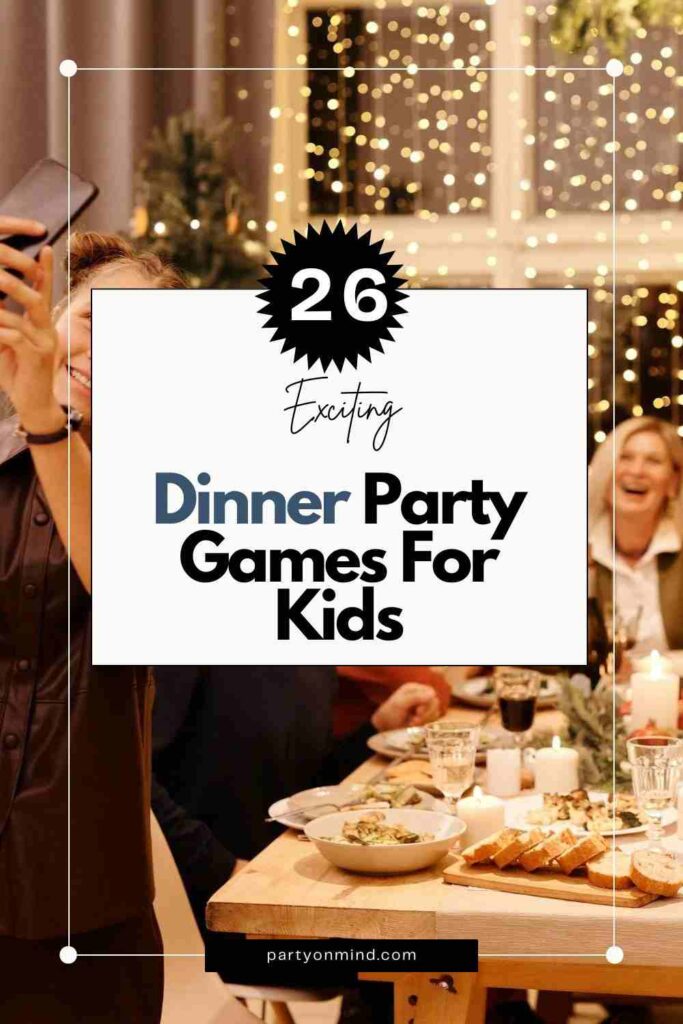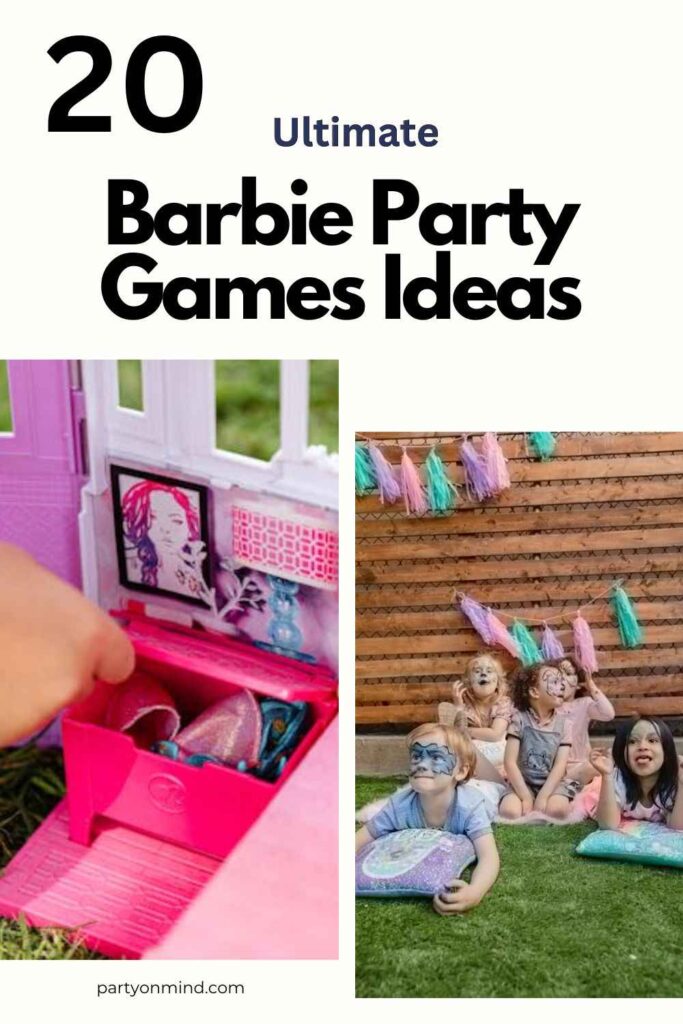Hi, I’m Emma, and I believe that dinner parties don’t just have to be about food; they can be fun and memorable for kids too! When hosting a gathering, Dinner Party Games for Kids can be a great way to keep young guests engaged and entertained throughout the meal. While adults might be focused on conversation and catching up, kids can sometimes get restless or bored during a long dinner. That’s where the magic of games comes in!
Dinner Party Games For Kids
Dinner Party Games for Kids add excitement and fun to mealtime, keeping children engaged and entertained. These games not only bring joy but also help encourage good table manners and social interaction.
Guess the Food
This classic game involves blindfolding kids and having them guess different food items by taste, smell, or texture. It’s a great way to make dinner more interactive and exciting.
View this post on Instagram
-
Use a variety of simple and safe foods that are easy to identify.
-
Blindfold each child to add an element of surprise.
-
Encourage kids to describe the food they taste in detail to help develop their vocabulary.
-
Offer small prizes for the correct guesses or give everyone a fun “food critic” title.
-
Keep the game short so it doesn’t take away from the meal.
Food Art Challenge
This game turns dinner into a creative activity! Kids use their food to create art by arranging it into funny shapes or designs on their plates.
-
Provide different types of food like fruits, veggies, and cheese to make designs.
-
Set a time limit for the challenge to keep things exciting.
-
Offer a “most creative” or “funniest design” prize at the end.
-
Allow kids to work individually or in teams, depending on the size of the party.
-
Make sure the food used for the art is edible and safe for all ages.
Tabletop Bingo
Create a bingo card with actions or events that could happen during dinner, like someone telling a joke or someone asking for more bread. The kids mark off the squares as they happen.
-
Prepare bingo cards in advance with various dinner-related actions.
-
Use fun and silly items on the bingo card, such as “someone spills their drink” or “someone laughs really loud.”
-
Give a small reward for the first person to get a full bingo.
-
Adjust the difficulty based on the age of the kids.
-
Use this game to get kids interacting with each other throughout the meal.
Dinner Conversation Starters
Turn dinner into an engaging conversation by providing kids with fun and quirky questions they can ask each other.
-
Prepare a list of silly, lighthearted questions like “If you were a superhero, what would your power be?” or “What’s the weirdest food you’ve ever eaten?”
-
Pass around conversation starter cards so every child has a turn to ask.
-
Encourage kids to share their answers aloud to keep everyone involved.
-
Keep questions age-appropriate to spark imagination.
-
Make sure the conversation stays light and fun—no serious or difficult questions.
Pass the Parcel with a Twist
This game involves passing a wrapped gift around the table while music plays. When the music stops, the child holding the parcel unwraps one layer and performs a challenge or answers a question.
-
Wrap the gift with multiple layers, and include small tasks or challenges between each layer.
-
The tasks can include things like “tell a joke” or “do a funny dance.”
-
Use a small prize that everyone can enjoy or share, like a candy or toy.
-
Play upbeat music to keep the energy high.
-
Make sure the challenges are simple and fun for all ages.
Dinner Plate Relay
This game turns the dinner table into a mini race track! Kids have to balance an empty or pretend dinner plate and pass it down the table as quickly as possible.
-
Use lightweight plates or make them out of paper to avoid accidents.
-
Make it a timed challenge to add excitement.
-
Have a few obstacles to weave through, such as placing items between players.
-
Ensure the rules are clear so everyone understands how to play.
-
Offer a fun prize for the fastest or most balanced runner.
Decorate Your Cupcake Contest
Give kids cupcakes and various toppings to decorate and create their own fun designs. This game allows them to express creativity while enjoying a sweet treat.
-
Provide a variety of frostings, sprinkles, and candy toppings.
-
Set a time limit to keep the game exciting and fair.
-
Give awards for the most colorful, creative, or funniest cupcake.
-
If you have a theme for the party, encourage designs that fit with it.
-
Make sure there are enough supplies for everyone to participate.
Build the Best Sandwich
Kids love building their own sandwiches, and it turns dinner into a fun challenge. Provide various ingredients and let them assemble their own masterpiece.
-
Offer a variety of bread, spreads, veggies, and proteins.
-
Set guidelines for a “balanced” sandwich to encourage healthy choices.
-
Have a taste-test session at the end to see who created the best sandwich.
-
If you’re working with younger kids, pre-cut the ingredients for safety.
-
Keep it lighthearted, and focus more on fun than perfection.
Food Toss
This game involves tossing soft food items like marshmallows into cups or bowls placed at different distances. It’s a fun and active way to keep kids entertained.
-
Set up different cups at varying distances to add difficulty.
-
Use safe, soft food like marshmallows or small pieces of fruit.
-
Keep score for added competition, or just let everyone play for fun.
-
Create different challenges, such as tossing the food with one hand or from a specific height.
-
Make sure there’s a clear “target” area to keep the game organized.
Musical Chairs (Food Edition)
Play a classic game of musical chairs but use food-related items as seats. When the music stops, kids must find a “seat” to land on, but instead of chairs, use items like plates or cups.
-
Make sure the seats are stable and safe for children.
-
Play fun, upbeat music that kids enjoy.
-
Create themed rounds, like “fruit chairs” or “dessert chairs.”
-
Make the game inclusive by letting everyone have a chance to sit.
-
Have a fun prize for the last child remaining in the game.
Tabletop Scavenger Hunt
Create a list of items that can be found on the dinner table or throughout the room. Kids race to find them, and the first one to collect all items wins.
-
List items like napkins, spoons, or specific types of food.
-
Make the scavenger hunt specific to the theme of the dinner (e.g., a holiday or birthday theme).
-
Provide hints or riddles to make the hunt more challenging.
-
Use a timer to add excitement and keep the game moving.
-
Reward the winner with a small prize or extra dessert.
Pin the Tail on the Donkey (Food Edition)
Adapt this classic game with a food twist. Instead of a donkey, use a food-related image like a giant pizza or ice cream cone, and kids take turns “pinning” the missing item.
-
Blindfold kids and let them try to pin the item onto the picture.
-
Ensure the game is safe and the pins or stickers are easy to remove.
-
You can add challenges, such as asking kids to do a funny dance before their turn.
-
Play with a timer to keep things fast-paced.
-
Make the prize something related to the food theme, like a cookie or candy.
Who Am I?
Kids take turns wearing a sticky note on their foreheads with the name of a food or character written on it. They ask yes-or-no questions to figure out who or what they are.
-
Choose foods or characters that are familiar to the kids.
-
Give hints or tips to keep the game moving if someone is stuck.
-
Allow the kids to ask as many questions as they like.
-
Make sure the questions are simple and understandable.
-
Add a fun twist by having kids act out their food or character for extra clues.
Truth or Dare: Dinner Edition
This game adds a playful spin to the traditional truth or dare game by making it dinner-themed. Kids either answer silly questions or perform fun tasks related to food.
View this post on Instagram
-
Include fun truths like “What’s the weirdest food you’ve ever eaten?” or dares like “Pretend to be a chef for 30 seconds.”
-
Keep it lighthearted to ensure everyone enjoys the game.
-
Offer small rewards for participation or the funniest performances.
-
Make sure dares are appropriate and safe for all ages.
-
Play in a group to get everyone involved in the fun.
Thank You Game
End the dinner on a positive note with a gratitude game. Kids take turns saying something they’re thankful for, whether it’s the food, the company, or something silly.
-
Encourage everyone to share at least one thing they’re grateful for.
-
Use this moment to help kids practice good manners and appreciation.
-
Keep the atmosphere positive and light.
-
Incorporate a small prize for the most creative or heartfelt thank you.
-
Make it a tradition at every dinner party to wrap things up with gratitude.
By adding these fun Dinner Party Games for Kids, your event will be a hit with the little ones, making dinner time more memorable and enjoyable for everyone!
Closing the Meal
As the dinner party draws to a close, it’s important to leave the kids with a positive and heartfelt ending. Not only does it give them a chance to reflect on the fun moments of the evening, but it also helps instill good manners and appreciation for the experience. These closing activities are simple yet meaningful, providing an opportunity for the kids to share kindness and gratitude before they leave the table.
Compliment Each Other
At the end of the dinner, everyone takes a moment to compliment the person sitting next to them. This fosters a sense of kindness and positivity, ensuring the kids leave with smiles on their faces.
-
Encourage kids to think of something specific they admire or appreciate about the person next to them.
-
Keep the compliments light and fun to ensure everyone feels comfortable.
-
Lead by example—start the activity by complimenting someone yourself.
-
Make sure every child has a chance to share a compliment to avoid anyone feeling left out.
-
This can be a quick but meaningful way to promote good behavior and friendships.
Thank You Game
Before leaving the table, each child shares something they are thankful for about the party. This could be something they enjoyed, like the food, a fun game, or a funny moment they had.
-
Ask each child to think of one thing they really enjoyed during the evening.
-
Encourage them to thank the host or the person responsible for that part of the party.
-
Use this moment to help children practice gratitude and appreciation.
-
Allow the kids to share funny or creative things they’re thankful for, which can add a lighthearted touch.
-
This activity sets a positive tone and makes the kids feel appreciated, ensuring everyone leaves with happy memories.
These small closing activities help create a lasting, positive impression on the children, making them feel valued while fostering gratitude and kindness.
FAQ
What are the best types of games for kids at a dinner party?
The best games for kids at a dinner party are those that are simple, interactive, and fun. Some popular options include “Guess the Food,” “Food Art Challenge,” and “Tabletop Bingo.” These games encourage creativity, teamwork, and social interaction, making the meal more enjoyable for everyone.
How do I keep the games suitable for different age groups?
To make sure the games are age-appropriate, adjust the complexity of the tasks or challenges. For younger kids, choose simpler games like “Decorate Your Cupcake” or “Tabletop Scavenger Hunt.” For older kids, consider games like “Guess the Food” or “Dinner Plate Relay” with added challenges to keep them engaged.
Do dinner party games need to be food-related?
While food-related games can add a fun theme, they are not necessary. You can mix in general party games, such as “Musical Chairs” or “Truth or Dare,” with a light, food-inspired twist. The key is to make the games engaging, interactive, and suitable for the kids’ interests.
How long should each game last?
Each game should last between 10 to 15 minutes to maintain energy and excitement throughout the dinner. Keeping the games short helps prevent kids from getting bored or distracted, allowing them to stay focused on the meal and the fun.

I’m Emma Rosenthal, an event planner based in New York City with a passion for bringing people together through unforgettable celebrations. I created partyonmind.com to share my best party ideas, wedding inspirations, and fun games for kids, adults, and everyone in between. Whether you’re planning a small gathering or a grand event, I love helping you make every occasion special with creative and engaging activities. Let’s make every party one to remember!
![Fun Party Games Ideas for Kids, Adults [Party On Mind]](https://partyonmind.com/wp-content/uploads/2025/02/on-1-316x90.png)


